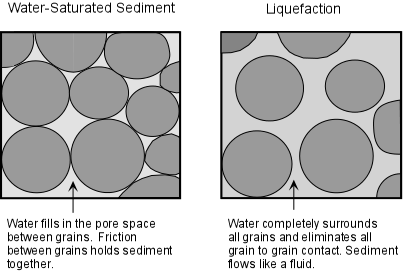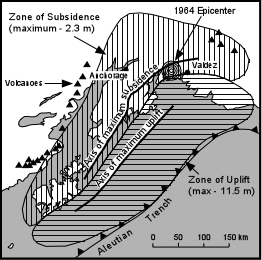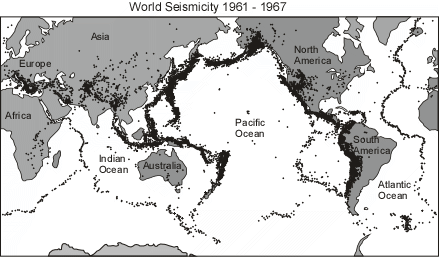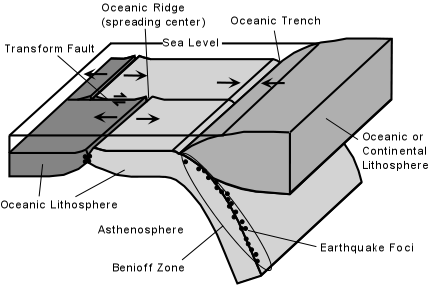Hazards Associated with Earthquakes
Possible hazards from earthquakes can be classified as follows:
Ground Motion - Shaking of the ground caused by the passage of seismic
waves, especially surface waves, near the epicenter of the earthquake are responsible for
the most damage during an earthquake and is thus a primary effect of an earthquake. The intensity of ground shaking depends on:
- Local geologic conditions in the area. In general, loose unconsolidated sediment
is subject to more intense shaking than solid bedrock.
- Size of the Earthquake. In general, the larger the earthquake, the more intense is
the shaking and the duration of the shaking.
- Distance from the Epicenter. Shaking is most severe near the epicenter and drops
off away from the epicenter. The distance factor depends on the type of material
underlying the area. There are, however, strange exceptions. For example, the 1985
Mexico City Earthquake (magnitude 8.1) had an epicenter on the coast of Mexico, more
than 350 km to the south, yet damage in Mexico City was substantial because Mexico City is
built on soft unconsolidated sediments that fill a former lake (see Liquefaction, below).
- Damage to structures from shaking depends on the type of construction.
- Concrete and masonry structures are brittle and thus more susceptible to damage
- wood and steel structures are more flexible and thus less susceptible to damage.
Faulting and Ground Rupture - Ground rupture generally occurs
only along the
fault zone that moves during the earthquake, and are thus a primary effect. Thus structures that are built across fault
zones may collapse, whereas structures built adjacent to, but not crossing the fault may
survive.
Aftershocks - These are smaller earthquakes that occur after a
main earthquake, and in most cases there are many of these (1260 were measured after the
1964 Alaskan Earthquake). Aftershocks occur because the main earthquake changes the stress
pattern in areas around the epicenter, and the crust must adjust to these changes.
Aftershocks are very dangerous because they cause further collapse of structures damaged
by the main shock. Aftershocks are a secondary effect of earthquakes
Fire - Fire is a secondary effect of earthquakes. Because power lines
may be knocked down and because natural gas lines may rupture due to an earthquake, fires
are often started closely following an earthquake. The problem is compounded if water
lines are also broken during the earthquake since there will not be a supply of water to
extinguish the fires once they have started. In the 1906 earthquake in San Francisco more
than 90% of the damage to buildings was caused by fire.
Landslides - In mountainous regions subjected to earthquakes ground
shaking may trigger landslides, rock and debris falls, rock and debris slides, slumps, and
debris avalanches. These are secondary effects.
|



